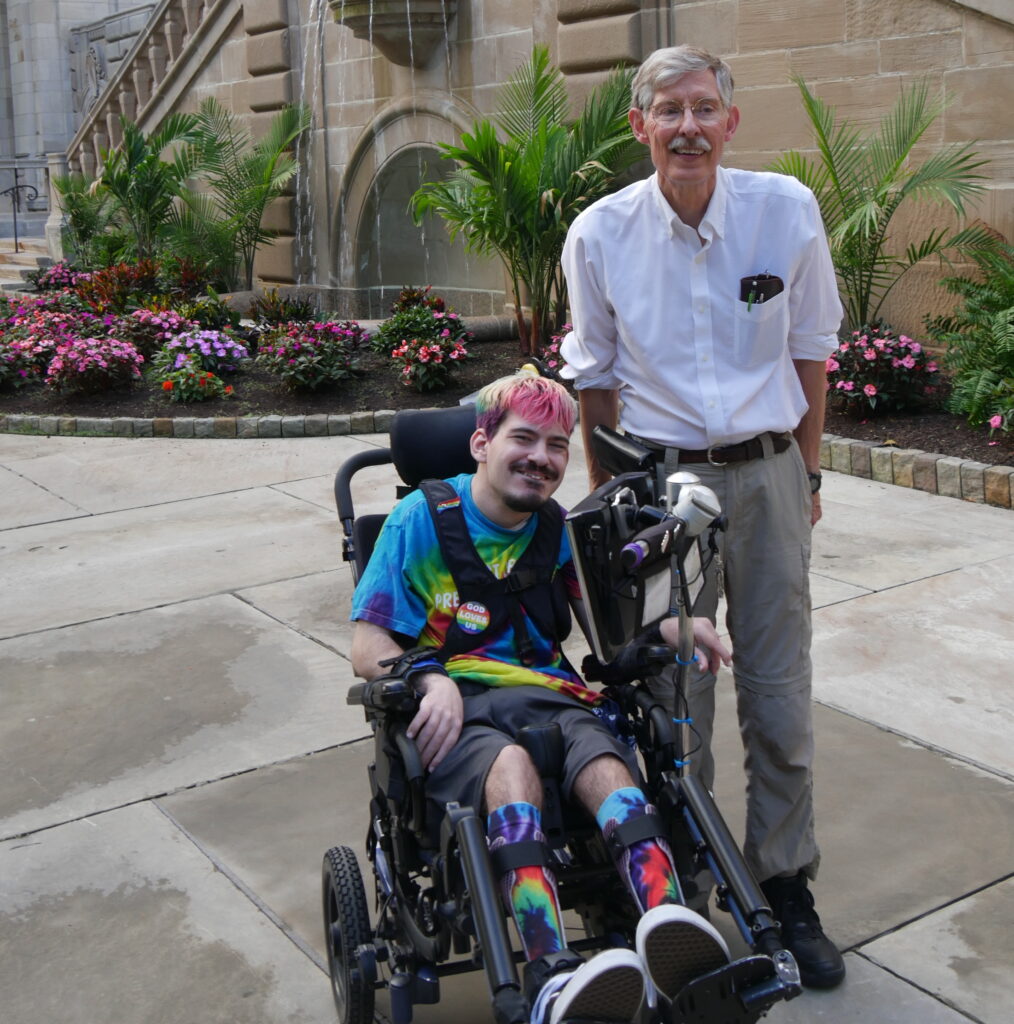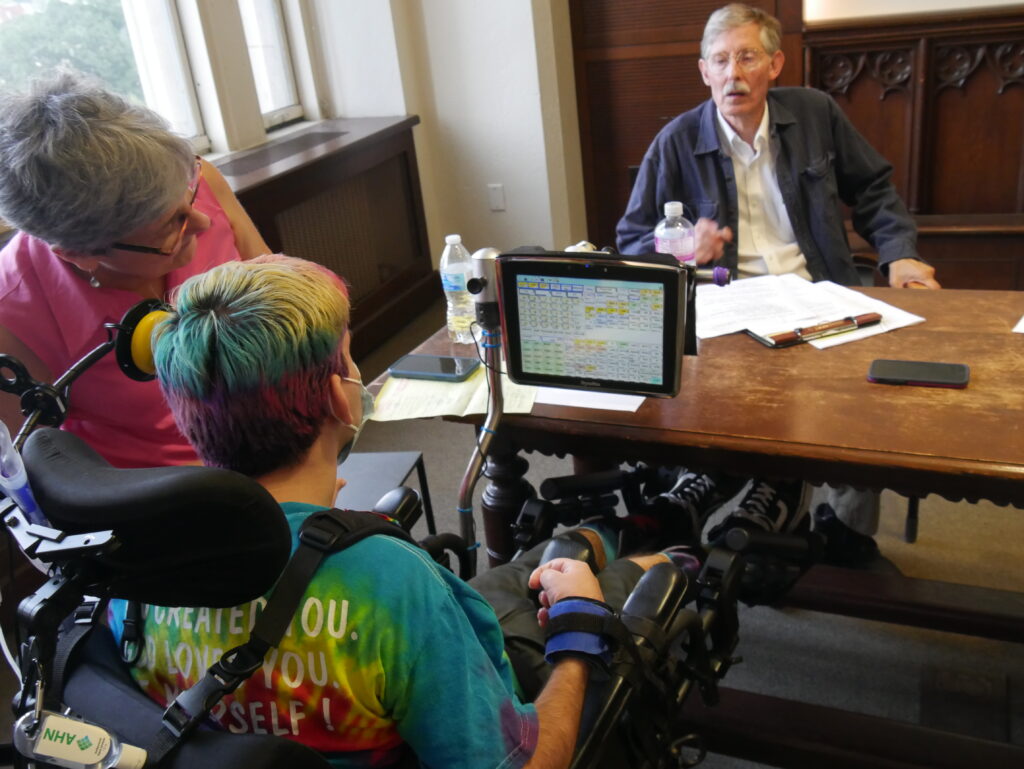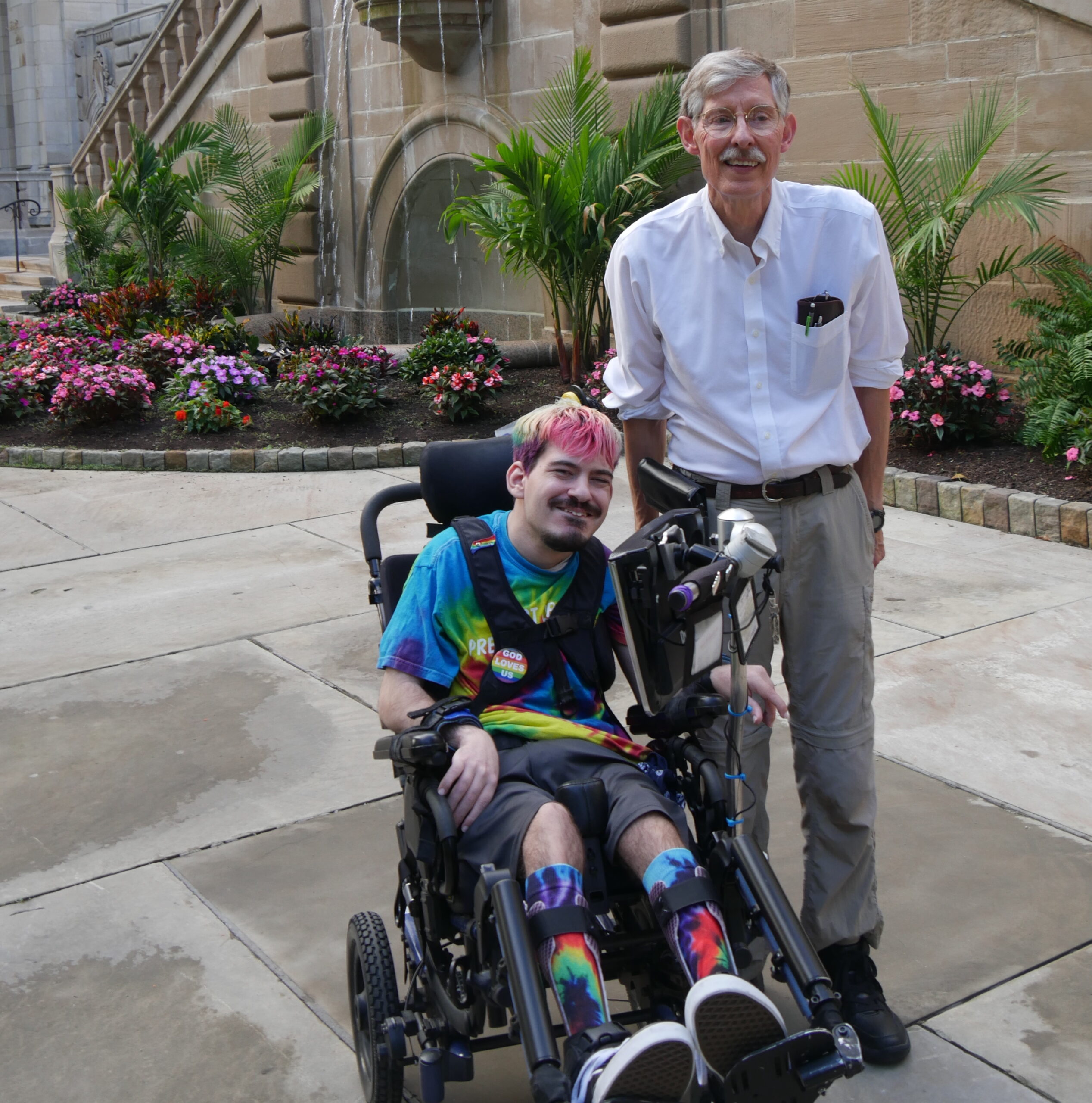The authors share how their journey began in poetry and ended in kinship.

Early one September evening, Mark Steidl and Richard St. John joined Sampsonia Way for a conversation about their genre-defying piece of writing titled “Freaky Fire Guy.” In a collage of narrative writing, photography, and poetry, their essay reveals Steidl’s experience as an LGBTQIA+ activist living in Pittsburgh with cerebral palsy. Steidl, 27, was diagnosed with cerebral palsy as an infant and has come of age, using a variety of technologies to manage his condition, including a DynaVox text-to-speech device. In “Freaky Fire Guy,” we see Steidl (who uses they/them pronouns) grow through the lens of their unique communication style, portraying a thoughtful, vibrant writer full of joy and imagination.
Their lyric essay is one entry from the newest digital anthology published by City of Asylum and edited by Ellen McGrath Smith, titled “Pittsburgh Live/Ability: Encounters in Poetry and Prose.” (You can enjoy their work — and many other amazing and daring pieces of writing — as both of an e-book and audiobook.) In “Freaky Fire Guy,” their vision came into being over the course of two years as Steidl and St. John — who is an accomplished Pittsburgh poet — worked together to build a collaborative partnership, incorporating emails, conversations, and found notes from Steidl’s younger years. In the end, their story is a metaphysical arc, revealing not only the beauty of Steidl’s vast imagination but the beauty of a blossoming friendship between Steidl and St. John.
On the night of our interview, as we first approached the two writers outside the Cathedral of Learning, the pairing made a striking juxtaposition — the younger Steidl in their wheelchair adorned by a complex attachment of computers and screens alongside the older St. John, tall and distinguished and friendly, his sparse, snow-white hair atop his head. Steidl’s sassy and stylish appearance couldn’t be any more set apart from St. John’s professorial beige-ness. While St. John wore khakis and a button-down, Steidl sported a tie-dyed rainbow socks, rainbow shirt, and rainbow hair — layered and blended into a complex ombré of color. Yet, in their writing — and in our conversation throughout the evening — the differences between the two writers never clash. Instead, their contrast gives life to a rare harmony. What emerges is their bond of companionship, their joy in language, and their shared desire to educate folks about the nature of disability — which, after all, is the purpose of the Pittsburgh Live/Ability project.
In her introduction to the anthology, Smith writes that the purpose of the project is to create a reflection of “what it was like for Pittsburghers with disabilities to try to live their best lives in this city and region. … to call forth all our pens, keyboards, vocal chords, assistive devices, and signing hands to give a dynamic, textured testimony to the diversity of the lives pursued in our city.” Sampsonia Way is lucky to have spent the evening with St. John and Steidl, along with Steidl’s mother, Tina Calabro — who helped give us invaluable insight. We crafted this conversation through email, before sitting down to get into even greater detail — and we’re eager to share the following conversation about the nature of disability, diversity, and what it took to write “Freaky Fire Guy.”
Mark, before this collaboration how did you view your work? How do you feel about your story being presented on such a public platform?
Mark: I view my work as a powerful story that needs to be understood by able-bodied people, and I’m excited to share it with the world. I’m especially interested in what reactions I am going to get because, to me, I view telling my story as an exercise in being vulnerable while loving myself. If I’m not vulnerable, I’m not telling my story right.
This is so wonderfully said. And I’m wondering, I guess from you, Rick, before this beautiful friendship developed, was it hard in the beginning stages to be able to get to the more vulnerable parts of Mark?
Rick: I’d like to come back to that when we talk a little bit more in-depth about the process. But yes, you’re spot on. That vulnerability is an important element of this thing. And I’ll just throw this in now. Mark, if we’d had that quote — “If I’m not vulnerable, I’m not telling my story right.” — that probably would have appeared somewhere in the story.
Okay. So, getting back into“Freaky Fire Guy,” Mark. What were some of your favorite moments?
Mark: I loved the line, “My 47th crash & burn” because it is very ironic yet very honest. It was more like my 300th! I also loved the section about the disabilities conference because it shows the freak in me and how self-confident I am as a gay man with cerbral palsy.
Rick: We knew that the disabilities party was going to be good on so many different levels of things. At the beginning, Mark expressed to me how much they loved being at the conference, because they could just be themself. They didn’t have masks. So it just emerged.
That line about the “47th crash & burn” is so good. It’s both heartbreaking and funny! [Editor’s note: It’s a line that comes from a moment in the narrative when communication between Mark and their interlocutor falls apart, and we apprehend how delicate the rhythm of the DynaVox is and how it takes such great patience from Mark.]
Rick: Mark’s speed of communication and what that means for communication was an important thing to get across. There are lines of dialogue in that section, where the rhythm breaks down, and I guess I made this up, but I had the idea of him trying to say hello to a couple of people and then to show the breakdown from different ways.
Mark, we’re curious about your process as an artist and writer collaborating in this piece with Rick. At what point did you feel that this narrative was special? We think it’s special!
Mark: I was always pushing Rick to write more about me. I wanted it to be so raw that a reader would feel uncomfortable putting down the piece, because they would be putting me down.
Did you feel emotionally prepared for the transparency this process required? Did this intimacy ever make you uncomfortable?
Mark: I’m an open book, so I never was uncomfortable.
We’re curious about your experience with the DynaVox — it creates a style of conversation that requires a lot of patience. What does this patience feel like to you?
Mark: I get impatient even typing, but I wouldn’t have it any other way because I have a sassy voice.

And then finally — to get into the process a little more, we wanted to ask you both about the collaborative experience. How did that unfold for you?
Mark: When we were emailing every day, the story unfolded naturally. Rick was kind enough to interview me over the course of the last two years by emailing me questions about my life experiences. And I would enthusiastically respond with stories and pictures. I also sent him a large packet of quotes that my mother gathered from me during my childhood.
Rick: The photographs were Mark’s idea specifically. “Why don’t you have a photograph for each of these sections?” And that clicked for me. That was a pretty genius idea.
[At the beginning,] I was imagining something a little more like a traditional poem, and I had never expected it to explode into all these different scenes and into a multi-genre kind of thing. At one point, when we first started working together, the idea was to start with a little bit of the interview process. And in my mind, I thought, “oh, this is gonna be a poetic kind of interview. I’m going to be listening to a lot of stories.” And I just wanted to ask Mark, What are your hopes for the readers to take away? Tell me about your story of when you were young. That kind of stuff. Right from the first workshop, it was clear that wasn’t going to work.
We started working with emails back and forth. I learned a number of good things there. But that dynamic still existed. Because Mark’s going to type the whole thing really slowly, really laboriously. He’s got totally vivid experiences, but it’s a big project to type all that out — in contrast to somebody who’s just typing regularly. I got a lot of good hints and clues from Mark, but I was still imagining I was just going to write a poem with Mark as the main character or the main speaker. I didn’t know where I was going.
Then Mark showed me a video of an instrumental piece that he had composed and showed me a video of some collaborative music with lyrics that he wrote. I thought “those lyrics are pretty cool.” So he sent the lyrics. We didn’t know they were gonna be in the piece yet, but some of these elements were starting to come together. I started to get the feeling that this piece needed to let the reader see Mark for the first time, sort of the way I saw him for the first time. And I wanted, as Mark said, to let it be a little raw.
Wow. Yes, that rawness and vulnerability really does shine through. And I think the direct quotations like the lyrics really make that happen. Can you tell us about the packet of quotes? How did those come to life?
Tina (Mark’s mother): So we’re going back. This is like really early childhood. At the same time you’re learning to read, usually you’re learning to write as well. And you’re trying some things. And it’s a lot of give and take. And so Mark was able to read things, look at storybooks, and follow along on a device. But without an alphabet, Mark couldn’t express themself, except through the pre-programmed things. But one of our speech therapists said, “Let’s just throw on an alphabet board with some word prediction and stuff. Let’s just throw it on there and see what happens.”
Mark used to pick all these letters, and then would click and see how it sounded. They would just play around with it just like all children learn to read by playing around with letters and sounds. Mark did actually teach themself to decode English to learn to write. When they started to write, they started to write in ways that kids do where they think they know how it sounds. When they started to do that, I started to write it down.
So, what I did is I had these yellow cards, and I decided to make these cards like my journal. And every time they say something, I’m just gonna write it down. Things like “two plus two plus one equals three.” Something they’re learning in school and communicating at home. And just anything else. We used to watch WQED, and Chris Fenimore is a cooking guy on TV. And we loved to watch him cook and everything. And one day, Mark was in another room, and was trying to tell me that the show was on. So Mark goes and spells it in his way that this Chris Fenimore is on TV: Mark spells it like qis femor. And it sound like “Keys Fee More.” And then I put it together, it’s like, “Oh, okay! I get it! Chris Fenimore. Chris is on TV!”
So I started to write these things down to see how that was all evolving. But then over time, Mark was learning to express themself, not just functionally, but sort of like, “I want to tell you what’s on my mind, what I’m thinking about.” And so as he would say these things, and I would write them down. These were like gems to me because in the day-to-day course of things, Mark wasn’t able to really get all this expressive language out. So when they did do it, I would write it down. I would enjoy it. I would read it over and over, because each piece of that was something new that I understood about my son. And so anyway, I told Rick: I have this big stack. Here you go!
Rick: If I had to say when I felt like we were on to something and “this-is-the-heart-of-it” — it was when I got those cards. The cards were like a gold mine. It was perfect. And it was so vulnerable. And so authentic.
Tina: I describe Mark’s utterances like a haiku. Because Mark has to condense what they’re saying, because it doesn’t really pay off to spend a lot of time with words, articles, and so forth that don’t contribute to the meaning. Mark’s way of expressing themself is condensed, because that’s going to give them the best chance to get their meaning across.
Rick: It became pretty clear that the way to use the quotes was semi-chronological, sort of moving from young to older. So you see the multi-dimensional elements of Mark’s experience building, but also poetically and in a flow. And then, [in the later stages] the fire poem seemed to me to be a pretty big thing, titled “Fine is Fire” and “Fine Fire.” And when that became the core of the ending section, I let Mark know that I was thinking that maybe we will call this thing “Fine Fire,” and he shoots back: “Freaky Fire Guy.” And I’m like, “Damn. That’s good, you know? … Yeah! Freaky fire guy. That catches it better than anything.”
And for one of the final elements, I settled on the Keats epigraph. Keats’s letter to George and Georgiana Keats. It’s about the process of how we’re not living in a “vale of tears.” We’re living in a vale of soul making. We’re all making our souls. And that struck me as really important. You can feel how we were groping through the whole thing, but it became clear to me. I think of the through line as Mark’s process of ongoing individuation and growth. And that’s where I kind of said, “Okay, this is how we’re going to organize this!” We’re going to see the Keats thing: seeing Mark grow through the quotes and then seeing Mark later in life and then seeing Mark move into the future. The idea of individuation moves through the piece all the way into the last line where we write: “They head off—into the day that he’ll make his.”
Leah Simpson is a staff writer for Sampsonia Way Magazine.
The Pittsburgh Live/Ability project is a literary collection that reflects the realities of life for Pittsburghers with disabilities. It is the creative culmination of two years of work between 11 multilingual, multiply disabled, and multiply abled Pittsburgh writers and 11 Pittsburghers with disabilities. The anthology is an intimate collaboration recounting what it means to translate oneself into an abled world, and the dynamic and textured diversity of lives pursued in our city. Pittsburgh Live/Ability is made possible by the generous support from: Fisa Foundation; Staunton Farm Foundation; and The Heinz Endowments


